Research on Spatiotemporal Land Deformation (2012–2018) over Xi’an, China, with Multi-Sensor SAR Datasets
Abstract
:1. Introduction
2. The Geological Background of the Study Area
3. Datasets and Method
3.1. SAR Datasets
3.2. GPS and Leveling Data
3.3. Method
3.3.1. SBAS-InSAR
3.3.2. Persistent Scatterer Candidate Selection and Regression Analysis
4. Results and Validation
4.1. Deformation Rates
4.2. Validation of InSAR Results
4.3. Calibration of InSAR Results
5. Analysis
5.1. Regional Land Subsidence Characteration
5.1.1. Land Subsidence in YHZ
5.1.2. Land Subsidence in the EC-JXC District
5.1.3. Land Subsidence in the SYC-FQY District
5.2. Land Subsidence along Subway Lines
6. Discussion
6.1. Correlation between Land Subsidence and Geology Characteristics
6.2. Correlation between Land Subsidence and Ground Fissures
6.3. Correlation between Land Subsidence and Underground Water Changes
7. Conclusions
Author Contributions
Funding
Acknowledgments
Conflicts of Interest
References
- Peng, J.B.; Fan, W.; Li, X.A.; Wang, Q.L.; Feng, X.J.; Zhang, J.; Li, X.S.; Lu, Q.Z.; Huang, Q.B.; Ma, R.Y.; et al. Some key questions in the formation of ground fissures in the Fen-Wei Basin. J. Eng. Geol. 2007, 15, 433–440. (In Chinese) [Google Scholar]
- Zhang, J.M. The structural features and the genetic mechanism of the surface crack belt in Xi’an, Shanxi Province. Geol. Shaanxi 1986, 4, 11–20. (In Chinese) [Google Scholar]
- Peng, J.B. Geohazards of Xi’an Ground Fissures; Science Press: Beijing, China, 2012; pp. 267–316. (In Chinese) [Google Scholar]
- Wan, W.F. Numerical Simulation of Land Subsidence Due to Groundwater Withdraw in Xi’an and Its Prevention Schemes. Ph.D. Thesis, Chang’an University, Xi’an, China, 2008. (In Chinese). [Google Scholar]
- Qu, F.F.; Zhang, Q.; Lu, Z.; Zhao, C.Y.; Yang, C.S.; Zhang, J. Land subsidence and ground fissures in Xi’an, China 2005–2012 revealed by multi-band InSAR time-series analysis. Remote Sens. Environ. 2014, 155, 366–376. [Google Scholar] [CrossRef]
- Chang’an University. Monitoring Land Subsidence and Ground Fissures over Fenwei Basin by Using InSAR and GPS Techniques; Inner Report; Chang’an University: Xi’an, China, 2009. (In Chinese) [Google Scholar]
- Chang’an University. Thematic Study of the Monitoring and Control of the Land Subsidence and Ground Fissure in Fenwei Basin; Inner Report; Chang’an University: Xi’an, China, 2009. (In Chinese) [Google Scholar]
- Chang’an University. Monitoring Land Subsidence and Ground Fissures over Fenwei Basin by using InSAR and GPS Techniques; Inner Report; Chang’an University: Xi’an, China, 2012. (In Chinese) [Google Scholar]
- Zhu, Y.Q.; Cheng, H.B.; Jiang, Z.S. The tectonic deformation and segmented features of Lintong–Chang’an fracture zone. Earthq. Res. Plateau 2005, 17, 18–26. (In Chinese) [Google Scholar]
- Zhang, Q.; Zhao, C.Y.; Ding, X.L.; Chen, Y.Q.; Wang, L.; Huang, G.W.; Yang, C.S.; Ding, X.G.; Ma, J. Research on recent characteristics of spatial-temporal evolution and mechanism of Xi’an land subsidence and ground fissure by using GPS and InSAR techniques. Chin. J. Geophys. 2009, 52, 1214–1222. [Google Scholar]
- Yan, W.Z. Analysis on the origin of land subsidence and its countermeasures of control in Xi’an. Chin. J. Geol. Hazard Control 1998, 119, 27–32. (In Chinese) [Google Scholar]
- Zhu, Y.Q.; Wang, Q.L.; Tian, Q.J.; Liang, W.F.; Zhang, X.L. Comprehensive analysis and study of crustal deformation in Guanzhong area. J. Geod. Geodyn. 2006, 26, 56–62. (In Chinese) [Google Scholar]
- Lu, Z.; Patrick, M.; Fielding, E.J.; Trautwein, C. Lava volume from the 1997 eruption of Okmok volcano, Alaska, estimated from spaceborne and airborne interferometric synthetic aperture radar. IEEE Trans. Geosci. Remote Sens. 2003, 41, 1428–1436. [Google Scholar]
- Massonnet, D.; Rossi, M.; Carmona, C.; Adragna, F.; Peltzer, G.; Feigl, K.; Rabaute, T. The displacement field of the Landers earthquake mapped by radar interferometry. Nature 1993, 364, 138–142. [Google Scholar] [CrossRef]
- Kang, Y.; Zhao, C.Y.; Zhang, Q.; Lu, Z.; Li, B. Application of InSAR techniques to an analysis of the Guanling landslide. Remote Sens. 2017, 9, 1046. [Google Scholar] [CrossRef]
- Ferretti, A.; Prati, C.; Rocca, F. Permanent scatterers in SAR interferometry. IEEE Trans. Geosci. Remote Sens. 2001, 39, 8–20. [Google Scholar] [CrossRef] [Green Version]
- Berardino, P.; Fornaro, G.; Lanari, R.; Sansosti, E. A new algorithm for surface deformation monitoring based on small baseline differential SAR interferograms. IEEE Trans. Geosci. Remote Sens. 2002, 40, 2375–2383. [Google Scholar] [CrossRef]
- Lanari, R.; Mora, O.; Manunta, M.; Mallorqui, J.J.; Berardino, P.; Sansosti, E. A small-baseline approach for investigating deformations on full-resolution differential SAR interferograms. IEEE Trans. Geosci. Remote Sens. 2004, 42, 1377–1386. [Google Scholar] [CrossRef]
- Zhang, L.; Ding, X.L.; Lu, Z. Ground settlement monitoring based on temporarily coherent points between two SAR acquisitions. ISPRS J. Photogram. Remote Sens. 2011, 66, 146–152. [Google Scholar] [CrossRef]
- Perissin, D.; Wang, T. Repeat-pass SAR interferometry with partially coherent targets. IEEE Trans. Geosci. Remote Sens 2012, 50, 271–280. [Google Scholar] [CrossRef]
- Werner, C.; Wegmuller, U.; Strozzi, T.; Wiesmann, A. Interferometric point target analysis for deformation mapping. IEEE Int. Geosci. Remote Sens. Symp. 2003, 7, 4362–4364. [Google Scholar]
- Bateson, L.; Cigna, F.; Boon, D.; Sowter, A. The application of the Intermittent SBAS (ISBAS) InSAR method to the South Wales Coalfield, UK. Int. J. Appl. Earth Obs. Geoinf. 2015, 34, 249–257. [Google Scholar] [CrossRef] [Green Version]
- Chen, B.B.; Gong, H.L.; Li, X.J.; Lei, K.C.; Zhu, L.; Gao, M.L.; Zhou, C.F. Characterization and causes of land subsidence in Beijing, China. Int. J. Remote Sens. 2017, 38, 808–826. [Google Scholar] [CrossRef]
- Dong, S.; Samsonov, S.; Yin, H.; Ye, S.; Cao, Y. Time-series analysis of subsidence associated with rapid urbanization in Shanghai, China measured with SBAS InSAR method. Environ. Earth Sci. 2014, 72, 677–691. [Google Scholar] [CrossRef]
- Bai, L.; Jiang, L.M.; Wang, H.; Sun, Q. Spatiotemporal Characterization of Land Subsidence and Uplift (2009–2010) over Wuhan in Central China Revealed by TerraSAR-X InSAR Analysis. Remote Sens. 2016, 8, 350. [Google Scholar] [CrossRef]
- Liu, Y.Y.; Zhao, C.Y.; Zhang, Q.; Yang, C.S.; Zhang, J. Land subsidence in Taiyuan, China, monitored by InSAR technique with multisensor SAR datasets from 1992 to 2015. IEEE J. Sel. Top. Appl. Earth Obs. Remote Sens. 2018, 11, 1509–1519. [Google Scholar] [CrossRef]
- Castellazzi, P.; Arroyo-Domínguez, N.; Martel, R.; Calderhead, A.; Normand, J.; Gárfias, J.; Rivera, A. Land subsidence in major cities of Central Mexico: Interpreting InSAR-derived land subsidence mapping with hydrogeological data. Int. J. Appl. Earth Obs. Geoinf. 2016, 47, 102–111. [Google Scholar] [CrossRef]
- Righini, G.; Raspini, F.; Moretti, S.; Cigna, F. Unsustainable Use of Groundwater Resources in Agricultural and Urban Areas: A Persistent Scatterer Study of Land Subsidence at the Basin Scale. WIT Trans. Ecol. Environ. 2011, 144, 81–92. [Google Scholar]
- Solari, L.; Ciampalini, A.; Raspini, F.; Bianchini, S.; Zinno, I.; Bonano, M.; Manunta, M.; Moretti, S.; Casagli, N. Combined use of C- and X-band SAR data for subsidence monitoring in an urban area. Geosciences 2017, 7, 21. [Google Scholar] [CrossRef]
- Zhao, C.Y.; Zhang, Q.; Ding, X.L.; Peng, J.B.; Yang, C.S. InSAR based evaluation of land subsidence and ground fissure evolution at Xi’an. J. Eng. Geol. 2008, 17, 389–393. [Google Scholar]
- Zhao, C.Y.; Zhang, Q.; Ding, X.L.; Lu, Z.; Qi, X.M. Monitoring of land subsidence and ground fissures in Xi’an, China 2005–2006: Mapped by SAR interferometry. Environ. Geol. 2009, 58, 1533–1540. [Google Scholar] [CrossRef]
- Shi, M. The Development Condition and Section Structure Characteristic of Xi’an Ground Fissures. Master’s Thesis, Chang’an University, Xi’an, China, 2009; pp. 10–26. (In Chinese). [Google Scholar]
- Peng, J.B.; Qu, W.; Ren, J.; Zhang, Q.; Wang, F. Geological factors for the formation of Xi’an ground fractures. J. Earth Sci. 2018, 29, 468–478. [Google Scholar] [CrossRef]
- Peng, J.B.; Sun, X.H.; Wang, W.; Sun, G.C. Characteristics of land subsidence, earth fissures and related disaster chain effects with respect to urban hazards in Xi’an, china. Environ. Earth Sci. 2016, 75, 1190. [Google Scholar] [CrossRef]
- Wright, T.J.; Parsons, B.E.; Lu, Z. Toward mapping surface deformation in three dimensions using InSAR. Geophys. Res. Lett. 2004, 31, 169–178. [Google Scholar] [CrossRef]
- Holzner, J.; Bamler, R. Burst-Mode and ScanSAR Interferometry. IEEE Trans. Geosci. Remote Sens. 2002, 40, 1917–1934. [Google Scholar] [CrossRef]
- Sowter, A.; Amat, M.B.C.; Cigna, F.; Marsh, S.; Athab, A.; Alshammari, L. Mexico City land subsidence in 2014-2015 with Sentinel-1 IW TOPS: Results using the Intermittent SBAS (ISBAS) technique. Int. J. Appl. Earth Obs. Geoinf. 2016, 52, 230–242. [Google Scholar] [CrossRef]
- Wegmuller, U.; Walter, D.; Spreckels, V.; Werner, C.L. Nonuniform ground motion monitoring with Terrasar-X persistent scatterer interferometry. IEEE Trans. Geosci. Remote Sens. 2010, 48, 895–904. [Google Scholar] [CrossRef]
- Wegmüller, U.; Werner, C.; Strozzi, T.; Wiesmann, A. Multi-temporal interferometric point target analysis. In Analysis of Multi-Temporal Remote Sensing Images – The Second International Workshop; World Scientific: Singapore, 2004; pp. 136–144. [Google Scholar]
- Ferretti, A. Nonlinear subsidence rate estimation using permanent scatters in differential SAR interferometry. IEEE Trans. Geosci. Remote Sens. 2000, 38, 2202–2212. [Google Scholar] [CrossRef]
- Lu, Y.; Ke, C.Q.; Zhou, X.; Wang, M.; Lin, H.; Chen, D.; Jiang, H. Monitoring land deformation in Changzhou city (China) with multi-band InSAR data sets from 2006 to 2012. Int. J. Remote Sens. 2018, 39, 1151–1174. [Google Scholar] [CrossRef]
- Wang, Y.Q.; Wang, Z.F.; Cheng, W.C. A review on land subsidence caused by groundwater withdrawal in Xi’an, China. Bull. Eng. Geol. Environ. 2018, 4, 1–13. [Google Scholar] [CrossRef]
- Zhang, J.J.; Zhang, H.X.; Zhang, M.S.; Li, Y.; Dong, Y.; Zhang, Q.G. A preliminary study of land subsidence in the F4 ground fissure, Yuhuazhai, Xi’an, China. J. Geol. Hazards Environ. Preserv. 2017, 28, 31–37. (In Chinese) [Google Scholar]
- Jiang, Z.W. Earth Fissure Formation Mechanism under the Role of Water and its Numerical Simulation. Ph.D. Thesis, Chang’an University, Xi’an, China, 2011. (In Chinese). [Google Scholar]
- Liu, Z. Waterflood restoration of ground subsidence in Xi’an. Western Times, 5 August 2011. (In Chinese) [Google Scholar]
- Okada, Y. Surface deformation due to shear and tensile faults in a half-space. Bull. Seismol. Soc. Am. 1985, 75, 1018–1040. [Google Scholar]
- Yang, C.S.; Zhang, Q.; Xu, Q.; Zhao, C.Y.; Peng, J.B.; Ji, L.Y. Complex deformation monitoring over the Linfen–Yuncheng basin (China) with time series InSAR technology. Remote Sens. 2016, 8, 284. [Google Scholar] [CrossRef]
- Kim, J.W.; Lu, Z.; Degrandpre, K. Ongoing deformation of sinkholes in Wink, Texas, observed by time-series Sentinel-1A SAR interferometry (preliminary results). Remote Sens. 2016, 8, 313. [Google Scholar] [CrossRef]
- Lu, Z.; Wicks, C., Jr. Characterizing 6 August 2007 Crandall canyon mine collapse from ALOS/PALSAR InSAR. Geomat. Nat. Hazards Risk 2010, 1, 85–93. [Google Scholar] [CrossRef]
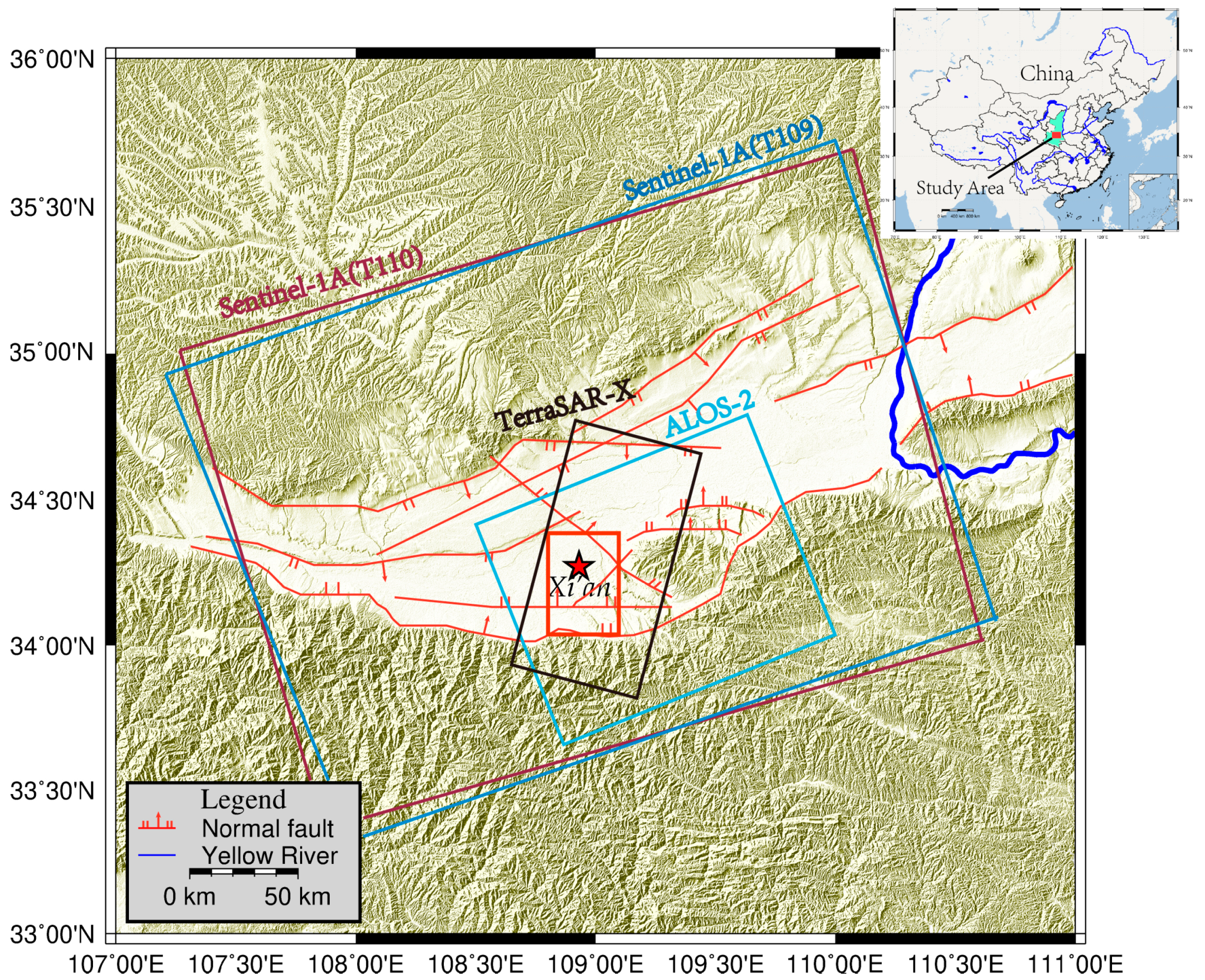
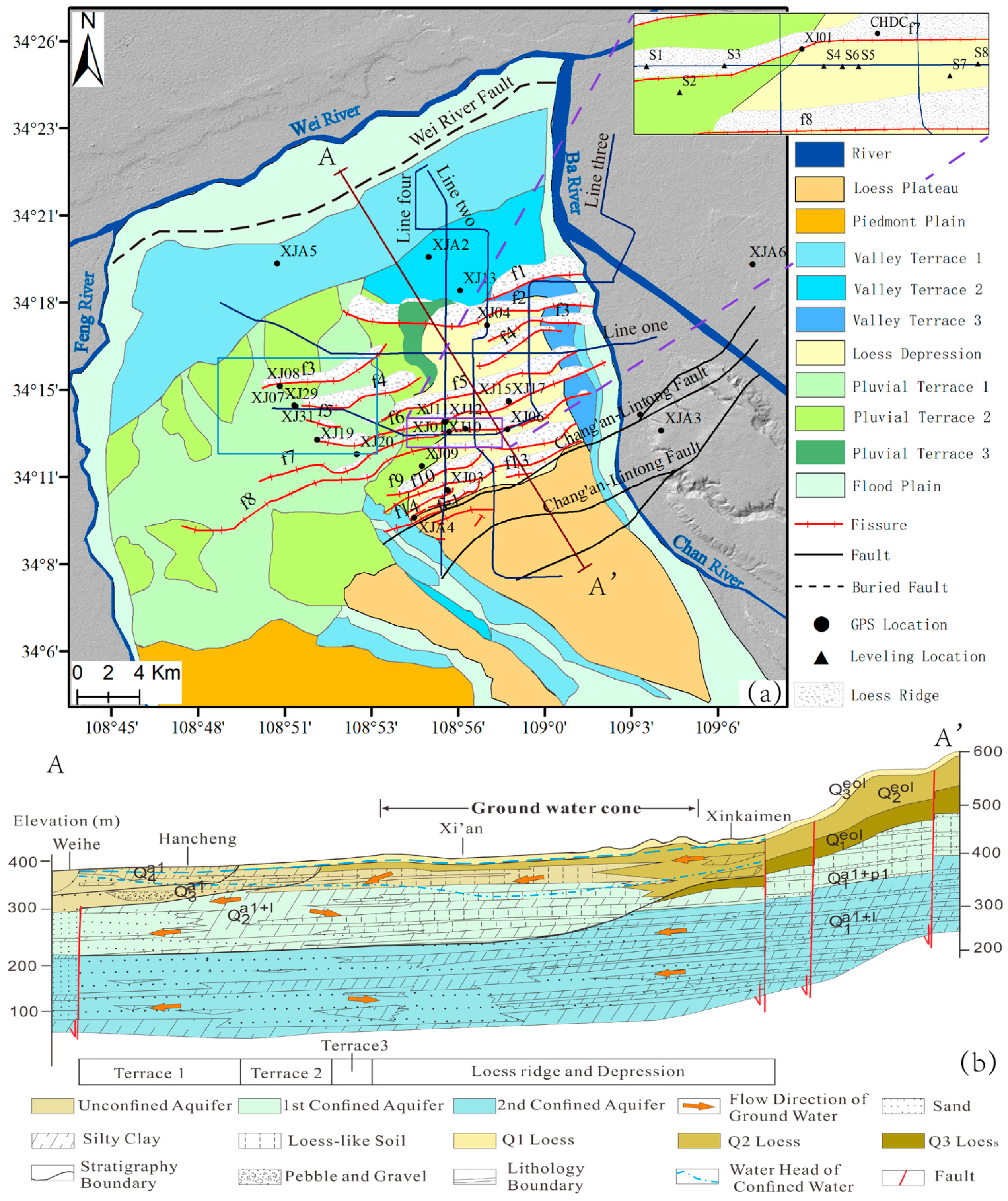



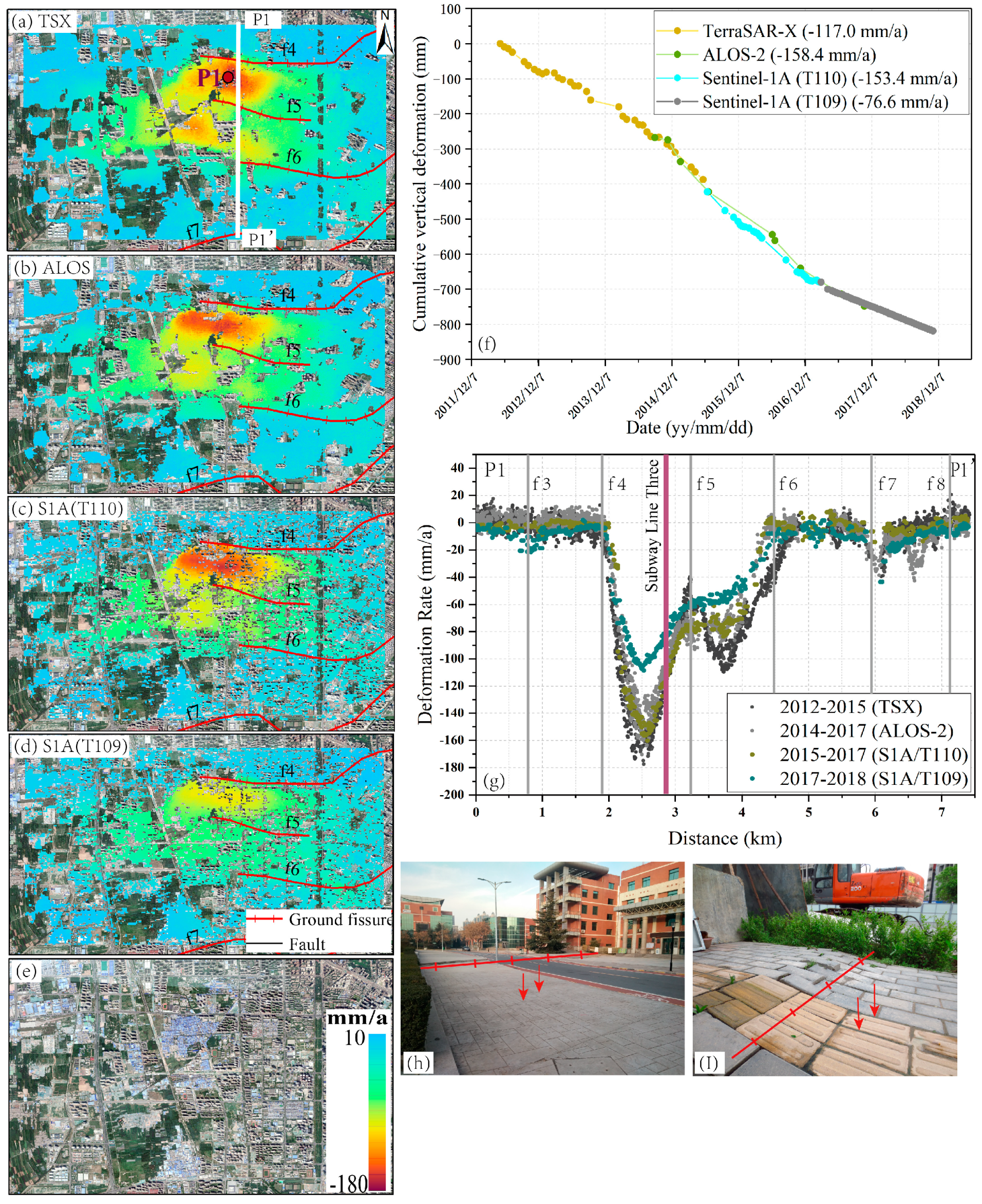
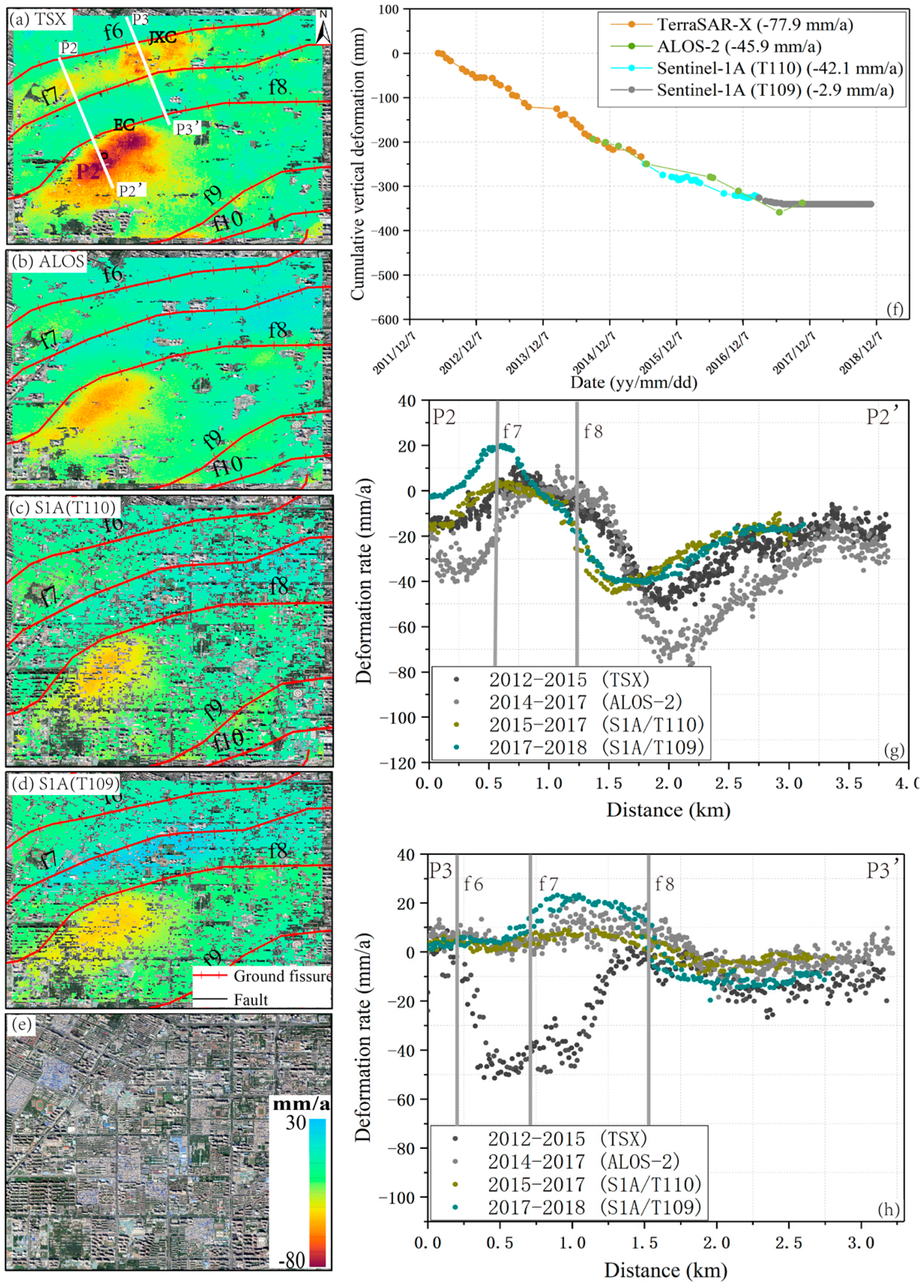
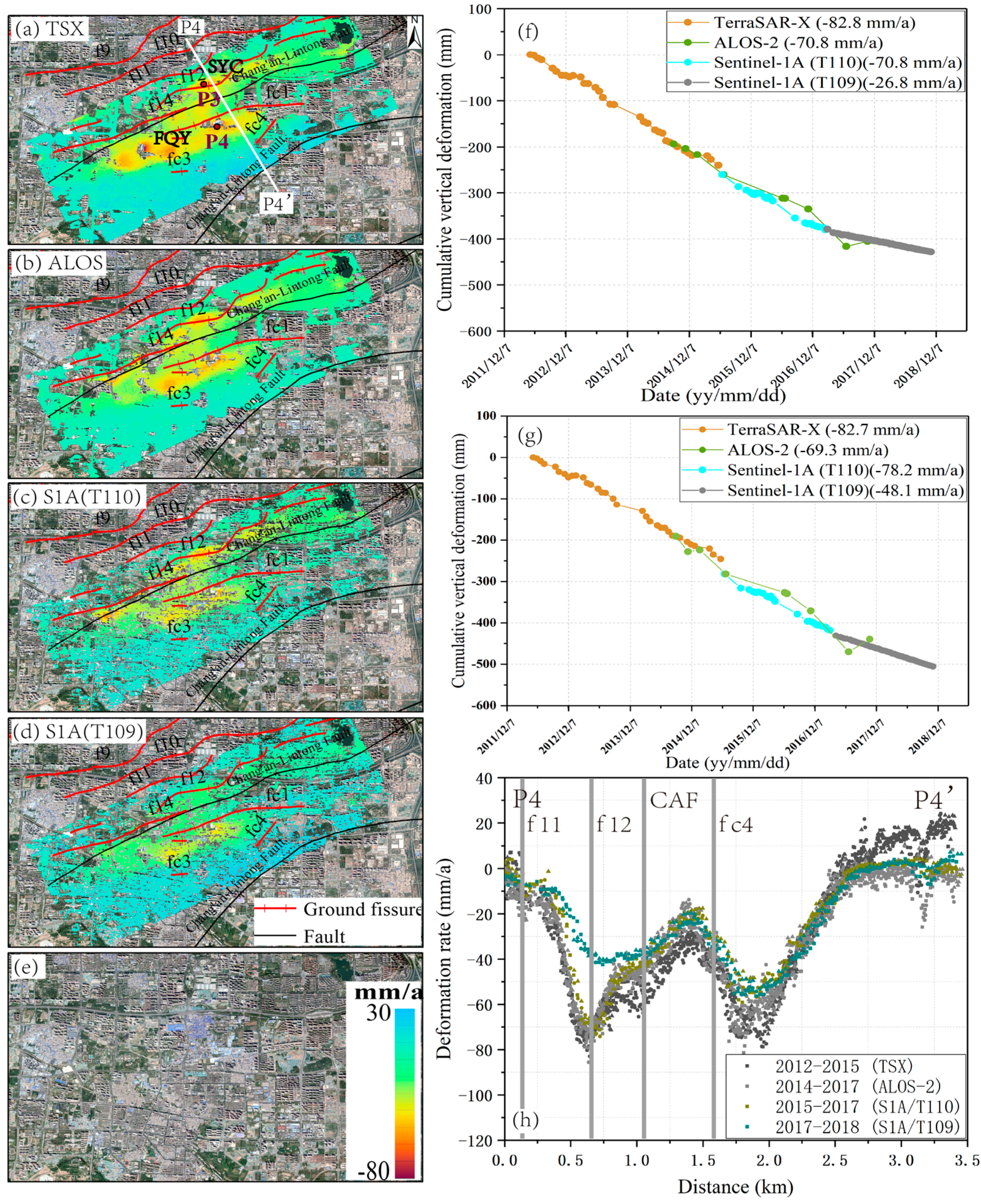

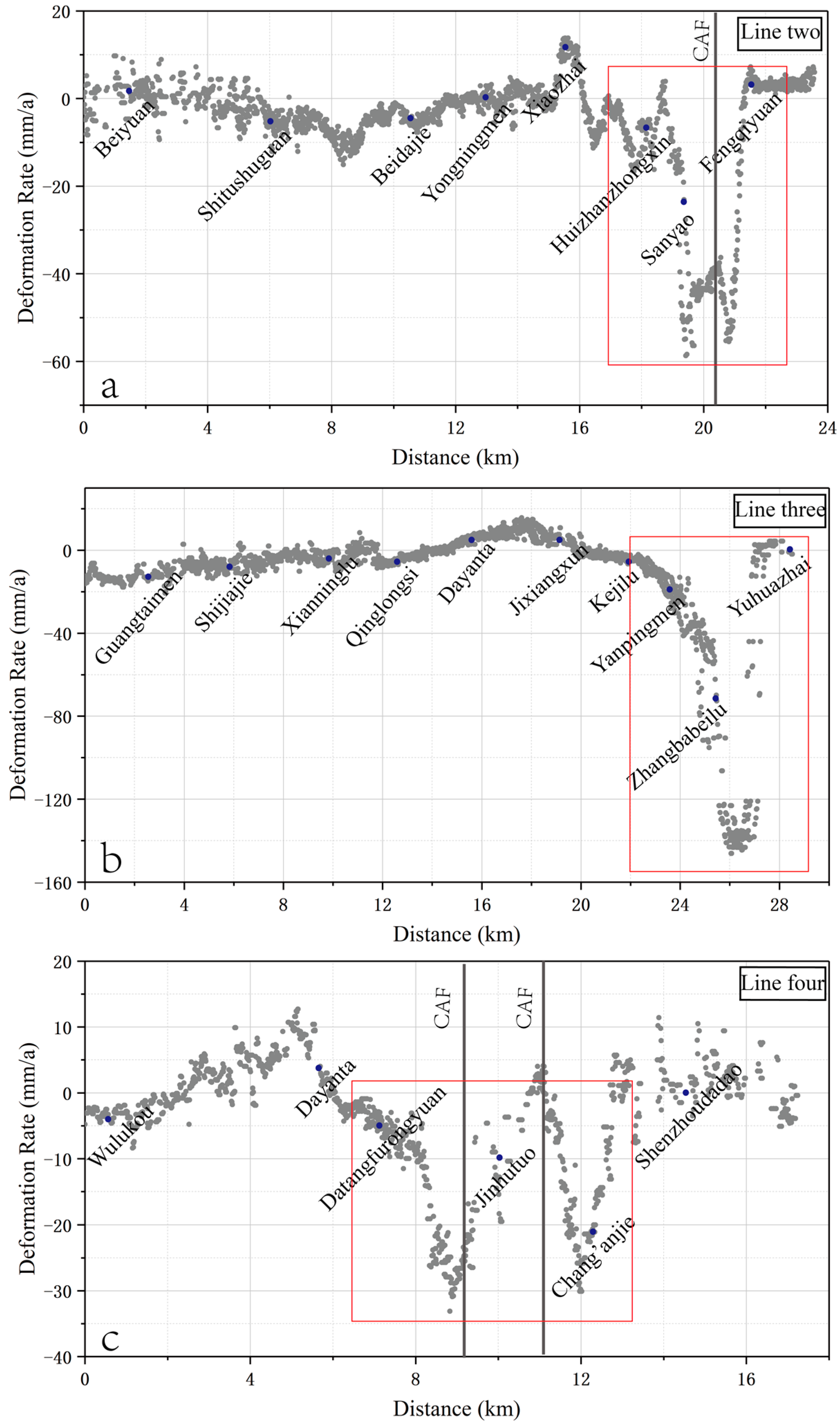


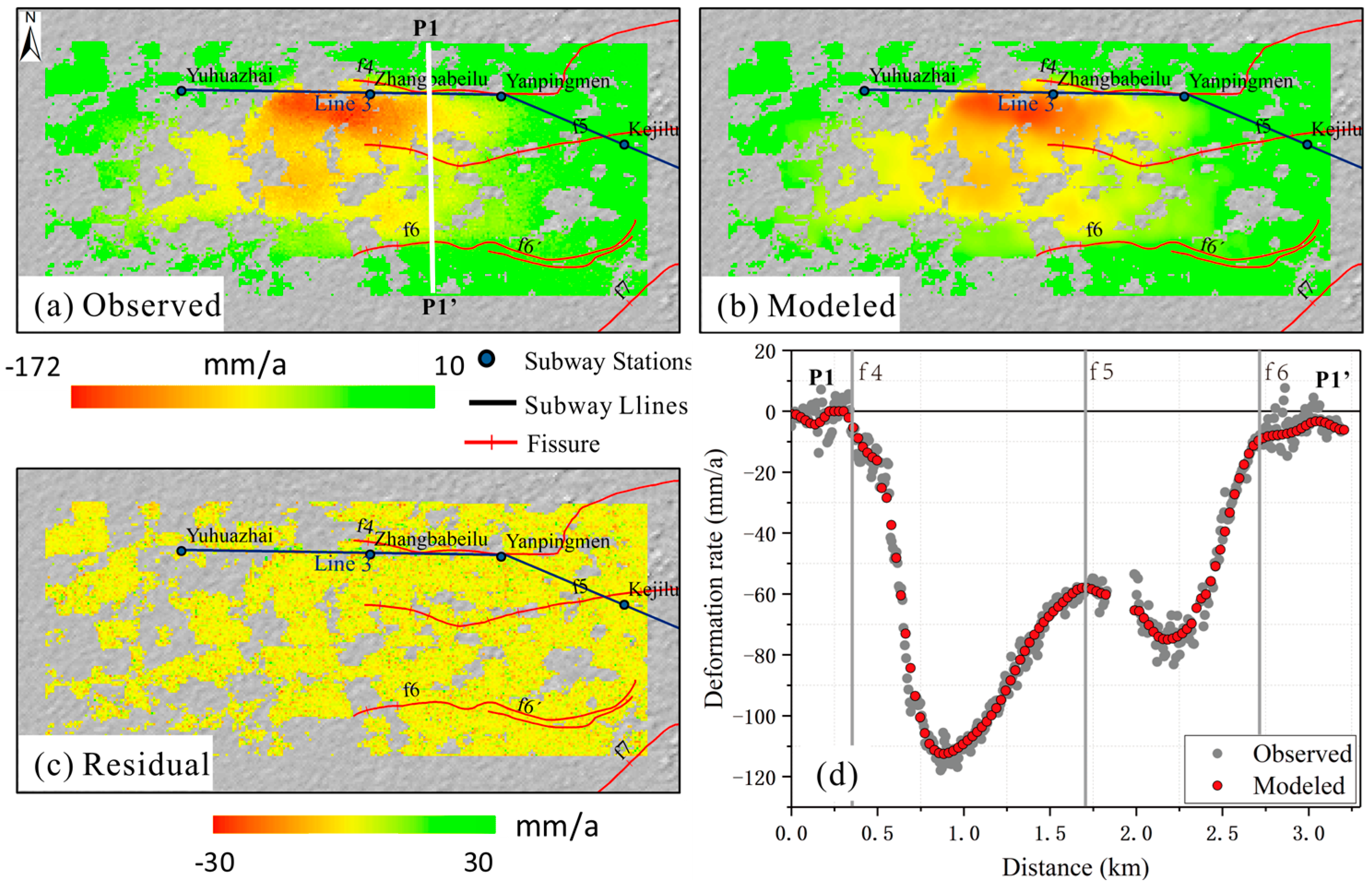

| Sensor | TerraSAR-X | Sentinel-1A | ALOS-2 | |
|---|---|---|---|---|
| Band (wavelength in cm) | X (3.1) | C (5.6) | L (23.6) | |
| Incident angle (°) | 28.6 | 39.2 | 40.5 | |
| Slant range spacing (m) | 0.9 | 2.3 | 4.2 | |
| Azimuth spacing (m) | 2 | 14.1 | 3.2 | |
| Pass direction | Descending | Ascending | Ascending | |
| Track number | 13 | 110 | 109 | 143 |
| Number of scenes | 37 | 29 | 52 | 9 |
| Date period | 2012/05/12–2015/05/28 | 2015/06/20–2017/03/05 | 2017/04/10–2018/11/07 | 2014/09/06–2017/10/28 |
| X (km) | Y (km) | Length (km) | Width (km) | Depth (km) | Dip Angle (°) | Strike Angle (°) | |
|---|---|---|---|---|---|---|---|
| Sill | 4 | 2.2 | 9 | 7 | 0.12 | 0 | 90 |
© 2019 by the authors. Licensee MDPI, Basel, Switzerland. This article is an open access article distributed under the terms and conditions of the Creative Commons Attribution (CC BY) license (http://creativecommons.org/licenses/by/4.0/).
Share and Cite
Peng, M.; Zhao, C.; Zhang, Q.; Lu, Z.; Li, Z. Research on Spatiotemporal Land Deformation (2012–2018) over Xi’an, China, with Multi-Sensor SAR Datasets. Remote Sens. 2019, 11, 664. https://doi.org/10.3390/rs11060664
Peng M, Zhao C, Zhang Q, Lu Z, Li Z. Research on Spatiotemporal Land Deformation (2012–2018) over Xi’an, China, with Multi-Sensor SAR Datasets. Remote Sensing. 2019; 11(6):664. https://doi.org/10.3390/rs11060664
Chicago/Turabian StylePeng, Mimi, Chaoying Zhao, Qin Zhang, Zhong Lu, and Zhongsheng Li. 2019. "Research on Spatiotemporal Land Deformation (2012–2018) over Xi’an, China, with Multi-Sensor SAR Datasets" Remote Sensing 11, no. 6: 664. https://doi.org/10.3390/rs11060664







